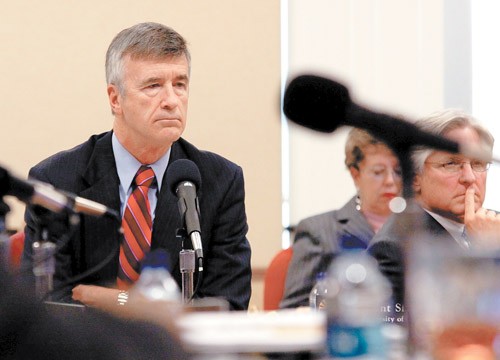Future state budget cuts and dwindling federal stimulus dollars were two key issues in the Arizona university system’s “”2020″” Vision at the Arizona Board of Regents meeting held in the Student Union Memorial Center Thursday.
In addition, the regents considered moving the university system’s tuition hearing, where the cost of tuition for fiscal year 2011 will be set, from March to January in order to promptly address a possible need for additional revenue.
The 2020 Vision, proposed by Sandra Woodley, chief financial officer and strategic planner for ABOR, centers on three primary goals:
To produce enough high-quality university degrees for the state to be nationally competitive by the year 2020.
To increase the prominence of the system’s research enterprise so that it can help improve the quality of life in Arizona.
To provide the educated workforce needed to fill shortages and to stimulate demand for higher paying jobs in Arizona.
“”We realize there is a very steep climb to get to our goal by 2020,”” Woodley said. “”When you get to enrollments, we have about 130,000 students on campuses. That will have to increase by 30 percent over the next 11 years.””
In 2008, the Arizona university system produced approximately 20,000 bachelor degrees. The 2020 Vision calls for a 42 percent increase by 2020, which would amount to an annual production of over 28,000 bachelor degrees. The UA will need to produce 8,100 more degrees annually by 2020, an increase of 44 percent.
While funding over the past several years has stayed relatively similar — FY 2010 saw $16,190 per student compared to $16,195 in FY 2008 — the sources of funding for the university system have changed dramatically.
Woodley said due to the temporary nature of the stimulus funds, the state is paying a much smaller share and the students a much greater one in terms of university funding.
In 2008, the universities had about a billion dollars in state appropriations. Due to significant decrease over the past few years, the university system plans to increase tuition revenue to approximately $1 billion by 2012.
The backbone of the proposed 2020 Vision will be a new system architecture that will utilize various low-cost options for students to earn a bachelor’s degree from a public university in Arizona.
Currently, the average total cost for a full-time student is $16,190 per year. When fully implemented, the lower cost degree options will amount to approximately $9,000, 43 percent less expensive, said Woodley.
According to the plan, over the next 10 years the UA will utilize existing relationships with community colleges, develop new online programs and develop community-based institutions that will grant degrees based on regional needs.
Most of the growth incorporated in the strategic planning over the next 11 years will be concentrated in the lower cost programs.
“”By 2020, 75 percent of our enrollment growth will come from new systems architecture,”” said Regent Robert Bulla. “”It is absolutely critical that the plan is implemented because I am not sure what we will be doing if it is not.””
Bulla proposed moving the tuition hearing from March to January in order to address pending budgetary concerns sooner rather than later.
“”I have been concerned for a long time that the crisis coming in the state is far greater than we understand,”” Bulla said.
Despite claims that increasing tuition is similar to increasing taxes, Bulla maintained that a possible tuition increase is not a tax but rather an investment with a return. In addition, Bulla said that regardless of whether or not the hearing is in January or March, the need to maintain the quality of higher education has to be addressed.
“”To educate, you are going to have to look at tuition levels that will exceed $10,000 by 2012,”” Bulla said.
Regent LuAnn Leonard and several other regents disagreed with Bulla’s proposed plan to move the tuition hearing forward.
“”The students are our customers and if we change the timeline when they are leaving and do not give them enough time for feedback, I think it would be seen as being non-transparent,”” Leonard said.
While the vote to move the tuition hearing forward failed 3-6, Bulla’s concerns that the university system will not have adequate funding in order to maintain a high level of quality was echoed by many members of the board and Council of Presidents.
“”Two thousand dollars (per student) in cuts already made, a $600 12-month surcharge, a temporary federal stimulus package, all which will expire and additional cuts are probable,”” said ASU president Michael Crow. “”That’s a precarious position for which timing is the means by which you win or lose.””
Thursday’s meeting ended with Regent Anne Mariucci voicing her discontent with submitting a five-year fiscal plan to the Arizona State Legislature.
“”All these techniques and tools to put political pressure on people and then we are going to turn in some strategic plans that have absolutely no bearing,”” she said. “”I never understood it. Make a statement that we can’t prepare a strategic plan, it doesn’t work and don’t submit it.””









